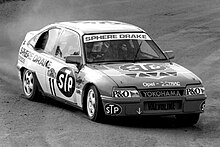Group S
The group S was racing a planned rally -Fahrzeugkategorie with which the world auto sports authority FIA in from the 1988 World Rally Championship cars of Group B wanted to replace. However, since there were several fatal accidents with Group B vehicles in the course of 1986, these were banned from the World Rally Championship by the FIA with effect from the end of the 1986 season and at the same time the plans for the introduction of Group S were discarded. Instead, cars that were homologated in Group A were used in the World Rally Championship from 1987 onwards .
Vehicle studies and planned regulations
Several works teams from automobile manufacturers involved in the rally scene had already dealt intensively with Group S and developed ready-to-drive prototypes that were deprived of their base due to the uncompromising decision of the FIA and that were therefore never used on the rally slopes of the world. While some of these vehicle studies were turned into pure exhibits at automobile fairs and automobile museums , a few were converted into competition cars in motor sports, in which prototypes or liberal one-offs were allowed to start. For example, the two Opel Kadett E Rallye 4 × 4 built by Opel in Rüsselsheim , which took part in the 1986 Dakar Rally as part of an extremely tough test program under the German Erwin Weber and the Belgian Guy Colsoul , later took part in the British rider John Welch were driven to various successes over several years in the European Rallycross Championship as well as in the British Rallycross Championship.
While a total of 200 copies of the relevant model had to be produced and presented to the FIA for a homologation in Group B, only 10 units were to be produced for Group S, which would have meant the possibility of building competitive rally cars even for less well-off teams. In addition, the performance of the Group S cars should be limited to a maximum of 300 hp (the displacement for turbo engines should not exceed 1200 cc and that for naturally aspirated engines 2400 cc), which also reduces the immense development costs of the group B, which is believed to have over 500 hp Motors wouldn't have become an issue. The plans of the FIA technicians were aimed at making the Group S vehicles themselves more stable and thus safer than those in Group B, and that they would have been easier to drive and therefore more controllable for the rally drivers due to a severe reduction in performance .
Group S prototypes
- Audi Sport quattro RS 002
- Lancia ECV (1 and 2)
- Opel Kadett E Rallye 4 × 4 (in Great Britain as Vauxhall Astra Mk2 4S in development and use)
- Toyota MR2 222D
Web links
- Racecar engineering: Group S? - A closer look at the stillborn replacement for Group B ( Memento from February 28, 2009 in the Internet Archive )
- Info and picture: Audi Sport quattro RS 002 (English)
- Info and pictures: Lancia ECV1 and ECV2 (English)
- Info and pictures: Opel Kadett Rallye 4 × 4 (English)
- Info and picture: Toyota MR2 222D (English)
- Info and pictures: Audi Sport quattro RS 002 (German)


